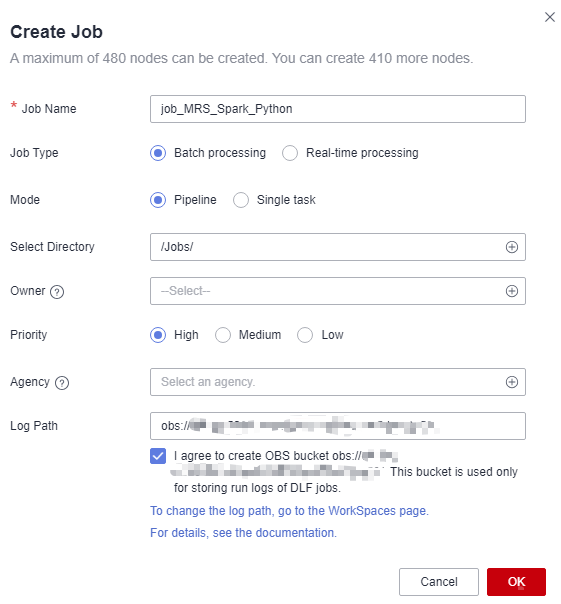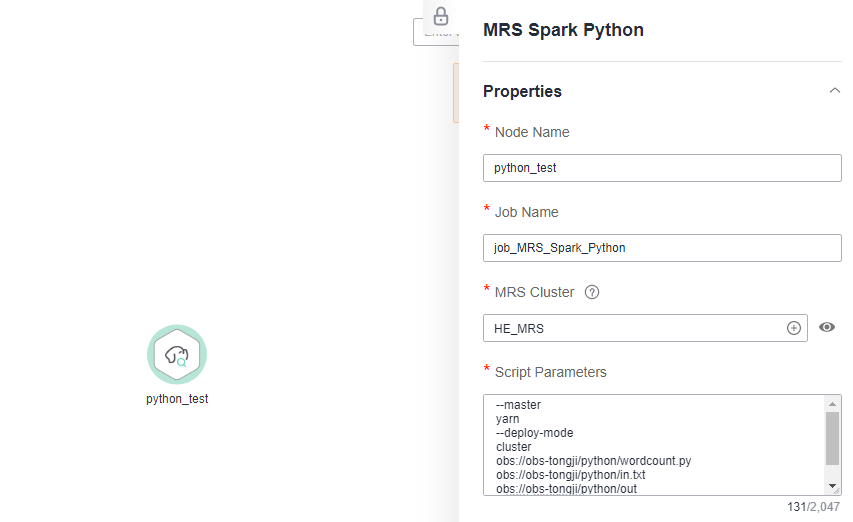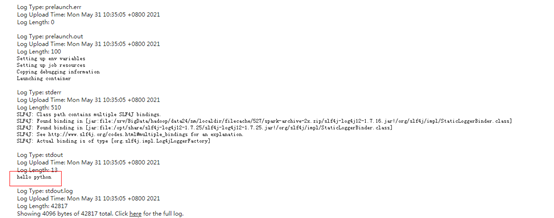Developing an MRS Spark Python Job
This section describes how to develop an MRS Spark Python on DataArts Factory.
Case 1: Using an MRS Spark Python Job to Count the Number of Words
Prerequisites
You have the permission to access OBS paths.
Data preparation
- Prepare the script file wordcount.py with the following content:
# -*- coding: utf-8 -* import sys from pyspark import SparkConf, SparkContext def show(x): print(x) if __name__ == "__main__": if len(sys.argv) < 2: print ("Usage: wordcount <inputPath> <outputPath>") exit(-1) # Create SparkConf. conf = SparkConf().setAppName("wordcount") # Create SparkContext. Pass the conf=conf parameter. sc = SparkContext(conf=conf) inputPath = sys.argv[1] outputPath = sys.argv[2] lines = sc.textFile(name = inputPath) # Split each line of data by space to obtain words. words = lines.flatMap(lambda line:line.split(" "),True) # Pair each word into a tuple count 1. pairWords = words.map(lambda word:(word,1),True) # Use three partitions (reduceByKey) for summarization. result = pairWords.reduceByKey(lambda v1,v2:v1+v2) # Print the result. result.foreach(lambda t :show(t)) # Save the result to a file. result.saveAsTextFile(outputPath) # Stop SparkContext. sc.stop()
The encoding format must be set to UTF-8. Otherwise, an error will occur during script execution.
- Prepare the data file in.txt, which contains some English words.
Procedure
- Upload the script and data file to the OBS bucket.
Figure 1 Uploading files to an OBS bucket


In this example, upload wordcount.py and in.txt to obs://obs-tongji/python/.
- Create an empty job named job_MRS_Spark_Python.
Figure 2 Creating a job

- Go to the job development page, drag the MRS Spark Python node to the canvas, and click the node to configure its properties.
Figure 3 Configuring properties for an MRS Spark Python node

Parameter descriptions:
--master yarn --deploy-mode cluster obs://obs-tongji/python/wordcount.py obs://obs-tongji/python/in.txt obs://obs-tongji/python/out
Specifically:
obs://obs-tongji/python/wordcount.py is the directory where the script is stored.
obs://obs-tongji/python/in.txt is the directory where the wordcount.py parameters are passed. You can pass the words to count.
obs://obs-tongji/python/out is the directory where output parameters are stored. This directory will also be created in the OBS bucket automatically. If the out directory already exists in the OBS bucket, an error will occur.
- Click Test to execute the script job.
- After the test is complete, click Submit.
- Choose Monitor Job in the navigation pane and view the job execution result.
Figure 4 Viewing the job execution result

The job log shows that the job was successfully executed.
Figure 5 Job run logs Figure 6 Job execution status
Figure 6 Job execution status
- View the returned records in the OBS bucket. (Skip this step if the return function is not configured.)
Figure 7 Viewing the returned records in the OBS bucket

Case 2: Using an MRS Spark Python Job to Print hello python
Prerequisites
You have the permission to access OBS paths.
Data preparation
Prepare the script file zt_test_sparkPython1.py with the following content:
from pyspark import SparkContext, SparkConf
conf = SparkConf().setAppName("master"). setMaster("yarn")
sc = SparkContext(conf=conf)
print("hello python")
sc.stop()
Procedure
- Upload the script file to an OBS bucket.
- Create an empty job.
- Go to the job development page, drag the MRS Spark Python node to the canvas, and click the node to configure its properties.
Parameter descriptions:
--master yarn --deploy-mode cluster obs://obs-tongji/python/zt_test_sparkPython1.py
zt_test_sparkPython1.py indicates the directory where the script is stored.
- Click Test to execute the script job.
- After the test is complete, click Submit.
- Choose Monitor Job in the navigation pane and view the job execution result.
Figure 8 Viewing the job execution result

- Verify the log.
Log in to MRS Manager and check that the log on YARN contains hello python.
Figure 9 Viewing logs on YARN
Feedback
Was this page helpful?
Provide feedbackThank you very much for your feedback. We will continue working to improve the documentation.






